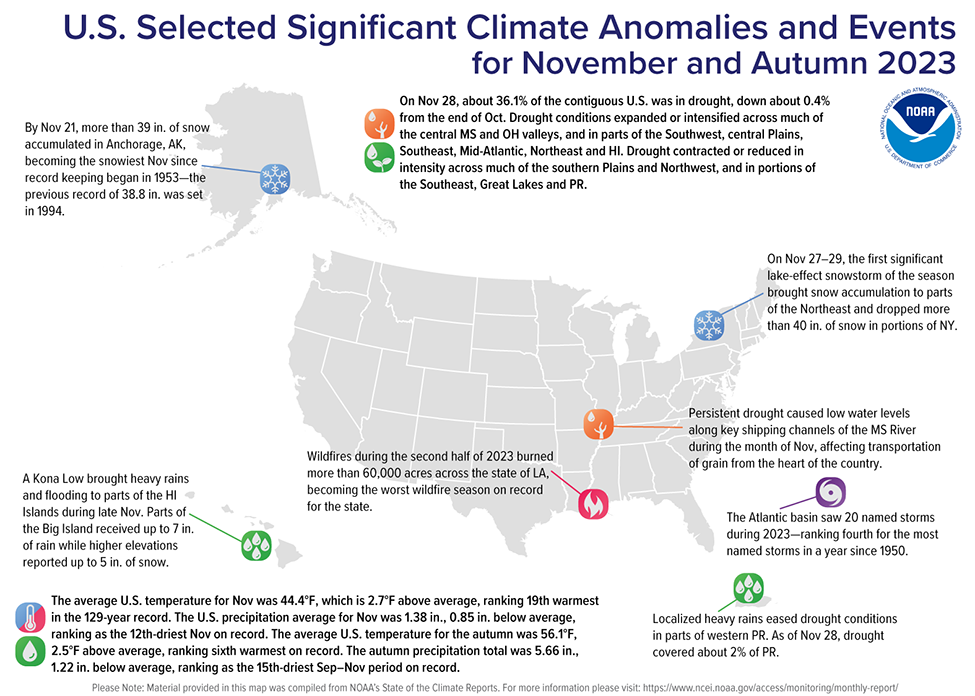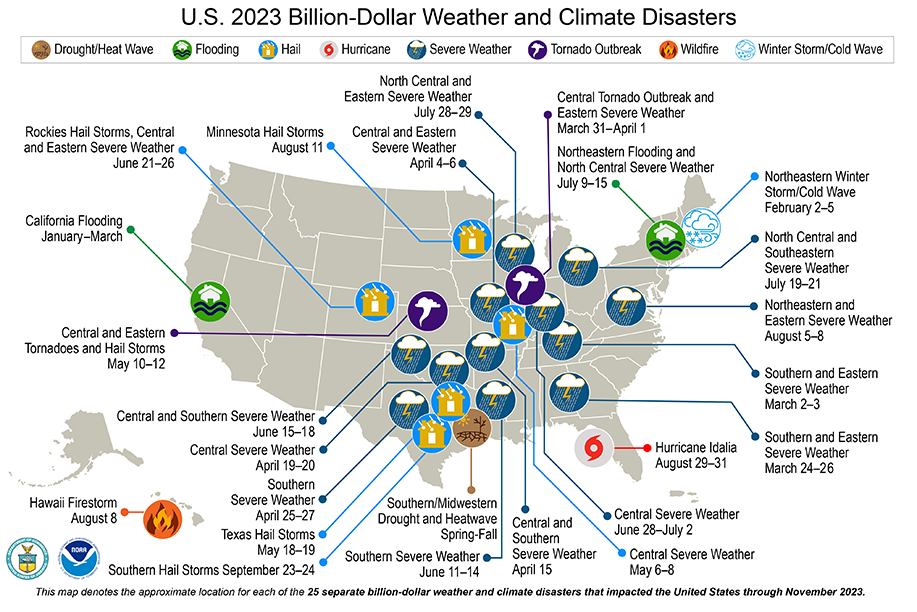
Last month wrapped up a remarkably warm meteorological autumn across the U.S., with the season ranking as the sixth-warmest autumn on record for the nation, according to scientists from NOAA’s National Centers for Environmental Information (NCEI).
A busy Atlantic hurricane season also came to a close, ranking fourth for the most-named storms in a year since 1950.
Below are highlights from NOAA’s U.S. climate report for November 2023:
Climate by the numbers
November 2023
The average November temperature across the contiguous U.S. was 44.4 degrees F (2.7 degrees above average), ranking as the 19th-warmest November in NOAA’s 129-year climate record.
November temperatures were above average across much of the U.S., while below-normal temperatures were observed in parts of the Northeast. No state in the contiguous U.S. saw its top-10 warmest or coldest November on record. However, Alaska saw its fourth-warmest November in the 99-year period of record for the state.
The nation’s average precipitation across the contiguous U.S was 1.38 inches (0.85 of an inch below average), ranking as the 12th-driest November on record. Indiana saw its third-driest November on record, while Illinois, Kentucky, Missouri and Wisconsin all saw a top-10 driest November. No state saw a top-10 wettest November.
Meteorological autumn
It was an exceedingly warm meteorological autumn (September through November) across the contiguous U.S. The average autumn temperature was 56.1 degrees F (2.5 degrees above average), ranking as the sixth-warmest autumn on record.
New Mexico and Texas saw their third-warmest autumns on record, while Maine saw its fourth warmest. Arizona, Colorado, Massachusetts, Minnesota, Montana, Nebraska, New Hampshire, Vermont, Wisconsin and Wyoming all had their top-10 warmest autumn.
The total autumn precipitation across the U.S. was 5.66 inches (1.22 inches below average), which ranked as the 15th-driest autumn on record. Tennessee’s autumn ranked as third driest, with three additional states — Indiana, Kentucky and Mississippi — seeing their top-10 driest autumn. No state ranked in their top-10 wettest on record for the September–November period.
Year to date (YTD, January through November 2023)
With just one month to go in 2023, the YTD average temperature across the contiguous U.S. was 55.8 degrees F — 2.0 degrees above average — ranking as the 10th-warmest such YTD in the record.
Louisiana, Mississippi and Texas each ranked warmest on record, while Connecticut, Florida and Massachusetts each ranked second warmest for the January–November period.
The YTD precipitation total for the contiguous U.S. was 26.89 inches, 0.70 of an inch below average, ranking in the driest third of the historical record.
Louisiana and Maryland ranked seventh and eighth driest on record, respectively, for this YTD period. Meanwhile, Wyoming ranked seventh wettest on record, while Maine, Nevada, New Hampshire and Vermont all saw their top-10 wettest such YTD.
Billion-dollar disasters
During the first 11 months of 2023, there were 25 separate weather and climate disasters across the U.S., each with losses exceeding $1 billion.
These disasters consisted of:
- 19 severe storm events.
- Two flooding events.
- One tropical cyclone.
- One winter storm.
- One wildfire event.
- One drought/heat wave event.
The 2023 Southern/Midwestern drought event has been the most costly U.S. disaster event of the year, with losses exceeding $10 billion. The total cost of the 25 events exceeds $81.0 billion.
Other notable highlights from the November report
- Hurricane season winds down: The 2023 Atlantic hurricane season officially ended on November 30, producing a total of 20 named tropical systems — ranking fourth for the most-named storms in a year on record. There were seven hurricanes and three major (Category 3 or higher) hurricanes. Hurricane Idalia was the only U.S. landfalling hurricane in 2023. It made landfall as a Category 3 hurricane near Keaton Beach, Florida, on August 30, causing storm surge inundation of 7 to 12 feet and widespread rainfall flooding in Florida and throughout the Southeast.
- Despite dry November, drought conditions improved slightly: According to the November 28 U.S. Drought Monitor reportoffsite link, about 36.1% of the contiguous U.S. was in drought, down about 0.4% from the end of October. Moderate-to-exceptional drought was widespread across much of the Lower Mississippi Valley, Tennessee Valley, central Great Plains and Southwest, with moderate-to-extreme drought over parts of the southern Great Plains, Hawaii and across parts of the Florida Peninsula. Moderate-to-severe drought was present in parts of the Northwest, Mid-Atlantic and New York.
NOAA


Bulloch Lifestyle
Downtown Live Concert Series This Thursday: Papa Sol

Chattooga Local News
ARC Selections Chickamauga Battlefield Connector Trail for Funding in Walker County

Bulloch Public Safety
05/01/2024 Booking Report for Bulloch County

Chattooga Schools
GNTC to hold 2024 Spring Commencement Ceremony May 2

Bulloch Public Safety
04/09/2024 Booking Report for Bulloch County

Bulloch Public Safety
04/08/2024 Booking Report for Bulloch County

Bulloch Public Safety
04/22/2024 Booking Report for Bulloch County

Bulloch Public Safety
04/15/2024 Booking Report for Bulloch County

Bulloch Public Safety
04/10/2024 Booking Report for Bulloch County





